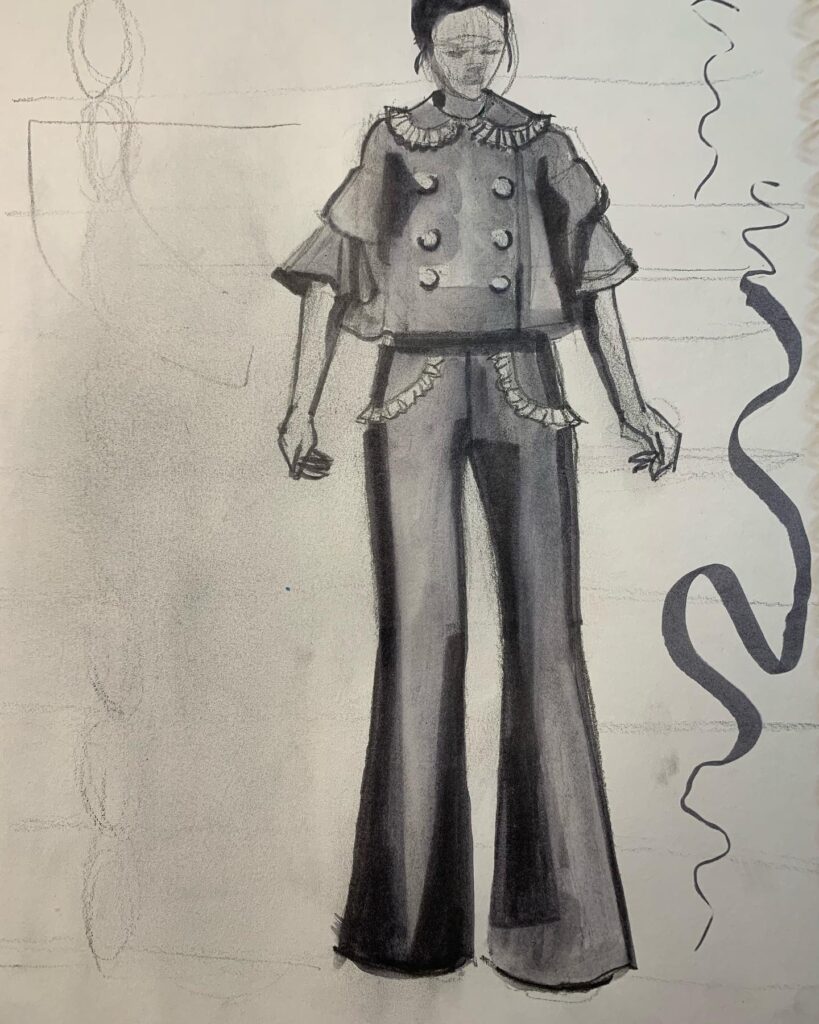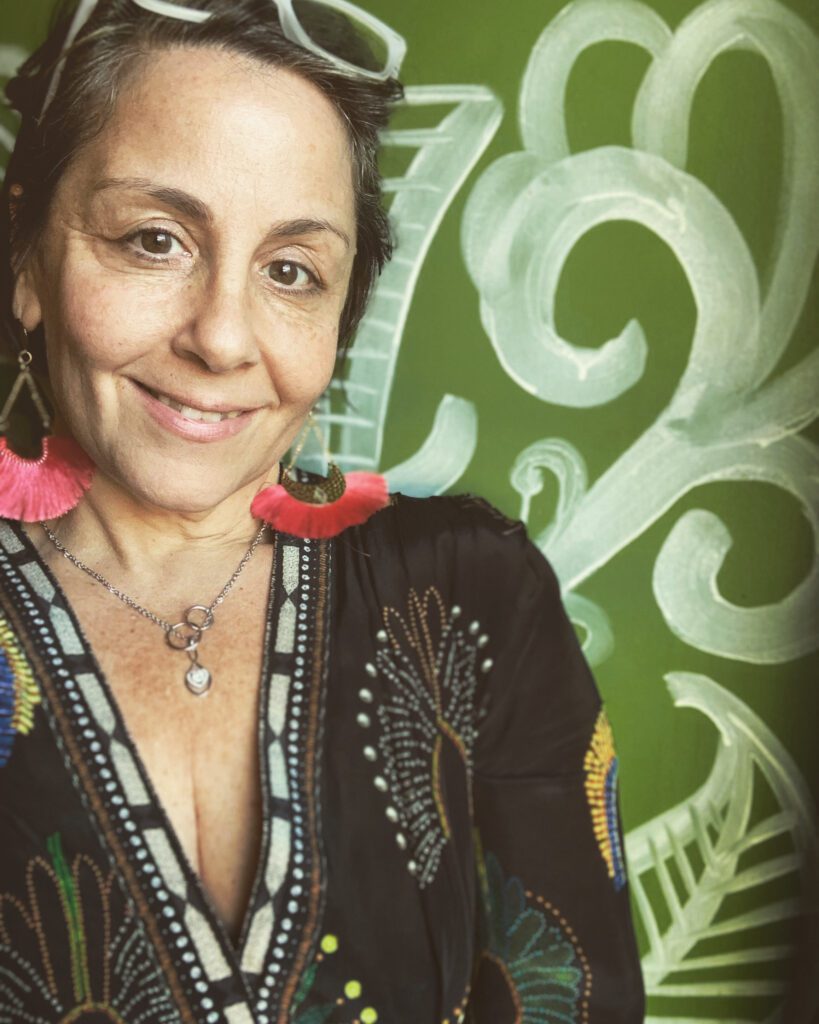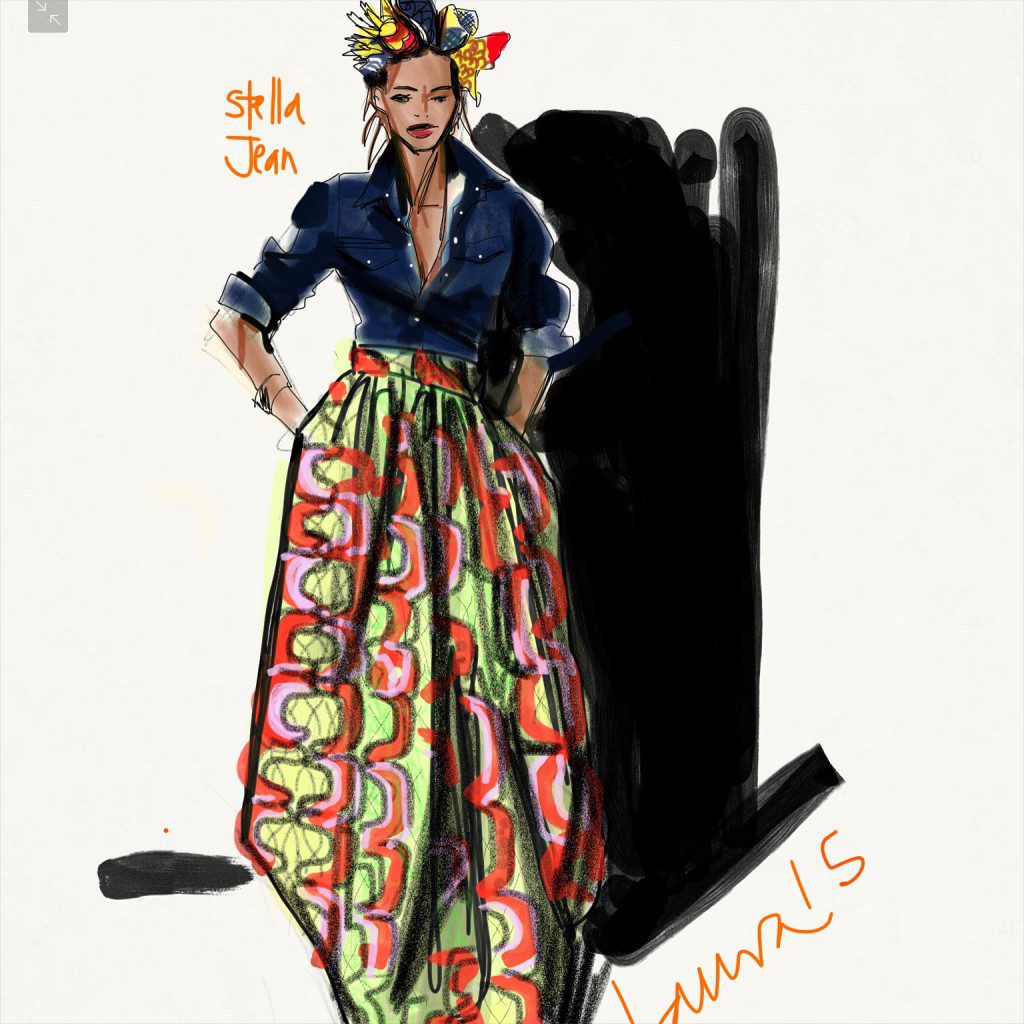Watercolor wash Technique with Tombow Brush Tip Marker
Today’s post is going to look at some of the range and possibilities available to you when you explore watercolor wash with markers for your fashion drawing!

*** PRO TIP: Even though I often start with pencil, that doesn’t mean I erase. I almost never erase! It’s a much more valuable skill to sketch super super lightly. If you prohibit yourself erasing, you’ll find that you automatically will develop the skill to sketch softly/faintly first. *******
After my pencil plan was laid out, I grabbed the Tombow Watersoluble Brush marker (“dual tip”) -if you look to the right of the image above, you’ll see a “ribbon” of grey to the right of my sketch. That’s my demonstration- giving you an illustration of the range of my brush tip marker! From super thin to super thick.
When I started inking my sketch I laid down the lightest, most delicate lines (fingers, ruffles, features) then went in with the thicker dark ones to add crispness, depth, contrast, and to separate layers. I also looked for areas where I could lay down dark tone shapes such as hair or large shadow
****Can you visually pick out these areas in the sketch above?*****
Just add water
The MAGIC really happened so fast when I added clean water with a brush! I always use a round, pointed brush to paint but I knew this group of students had flat square brushes so I used the same- and loved how quickly the areas became full of tone! The shimmery sheen of the fabric came to life when I added water, and the shadows blended into the grey of the suit.
I left the skin, buttons, and pleated ruffle trim white so that it would really pop and contrast with the other fabric in this suit by Pintel. I wish I could show you what this looked like before the water was added to see and feel the difference.
What exactly IS a watercolor wash?
A wash is a diluted, sheer tone created from (usually) watercolor. A brush loaded with clear, clean water can be used to spread out the pigments that your marker lines are holding, and spread to soften them into a transparent tone. In Fashion Sketch Group this week as well as in my college classes I had students explore the range of this unique expressive capability.. Spending time getting experienced with a technique leads to embodiment– it becomes a natural part of your process through experience.
(pssssss- I also love to do watersoluble graphite for watercolor wash fashion drawing effect but that will have to be a future post…. subscribe to stay in the loop!)
 TOMBOW BRUSH PEN SKETCHES IWTH WATER APPLIED WITH A BRUSH FOR FASHION ILLUSTRATION BY LAURA VOLPINTESTA
TOMBOW BRUSH PEN SKETCHES IWTH WATER APPLIED WITH A BRUSH FOR FASHION ILLUSTRATION BY LAURA VOLPINTESTA
Compared with the “before” image below, notice how a few broad strokes of watercolor wash made a huge difference in the feel of the sketch. WHAT DO YOU PREFER? There isn’t a right or wrong answer here. Just notice how each makes you feel, and consider which situations would call for which technique, in your opinion.
 Dry Tombow brush tip marker fashion sketch by Laura Volpintesta
Dry Tombow brush tip marker fashion sketch by Laura Volpintesta
Versatility of Markers with Wash technique:
To further emphasize the MASSIVE VERSATILITY of brush tip watercolor marker wash for fashion illustrations, compare now with the fashion drawing below of a circle skirt , with all of its ripples, flounces and flares, and WITHOUT the watercolor wash effect.
All of the circular flare is illustrated with chunky shapes that taper from wide and thick, to thin… almost like long, skinny triangles (cones, actually)! Also it’s great at articulating the ripples of the hem, the sleeve cuffs, wrap front, collar, and grosgrain ribbon belt! (Dress by Stella Jean with African print headscarf)
Later that day I taught another class and sketched the same dress. This time you can see how the Tombow watercolor marker with a brush tip was used again, but then I came quickly with my clean wet brush and created a watercolor wash from my lines, below.
It’s a whole different feeling!
And in this case, I used a round and pointed brush.
***PRO TIP: The excessive page wrinkling in the second drawing below comes from the fact that I was just using sketch paper. Use Bristol vellum or watercolor paper for a smooth page. Tape down all of the edges before you sketch, and don’t remove until your watercolor is all dry.

Crisp and clean, line without wash. dark and light grey brush tip markers used. Fashion Sketch by Laura Volpintesta

(Also, note that I used a dark grey watercolor marker- it wasn’t black to begin with.
I KNOW:
Brush tip marker is a big difference from using just flat line, but your line itself deserves plenty of attention. I would explore wash as well as pure line drawings, maybe on different days, to notice the way you feel as you use each technique for different situations and results.

Black Tombow watercolor brush marker
Join me in a self study like Model Drawing Magic or a group live program Fashion Sketch Group or Body Language for a deeper dive with support and encouragement! YOU CAN BEGIN TODAY!
Love, Laura














